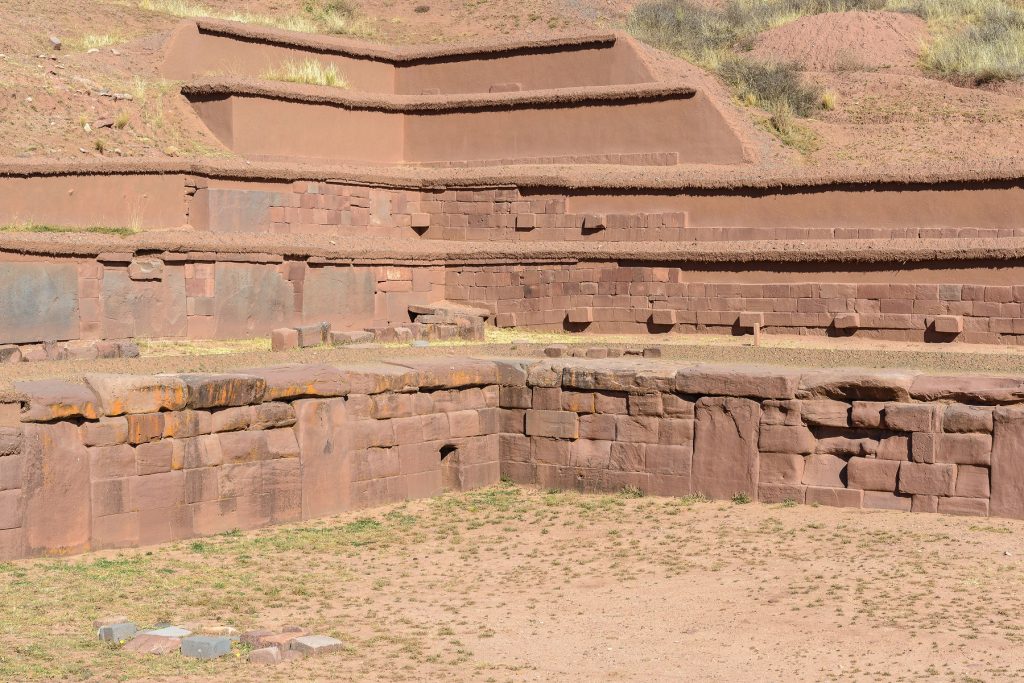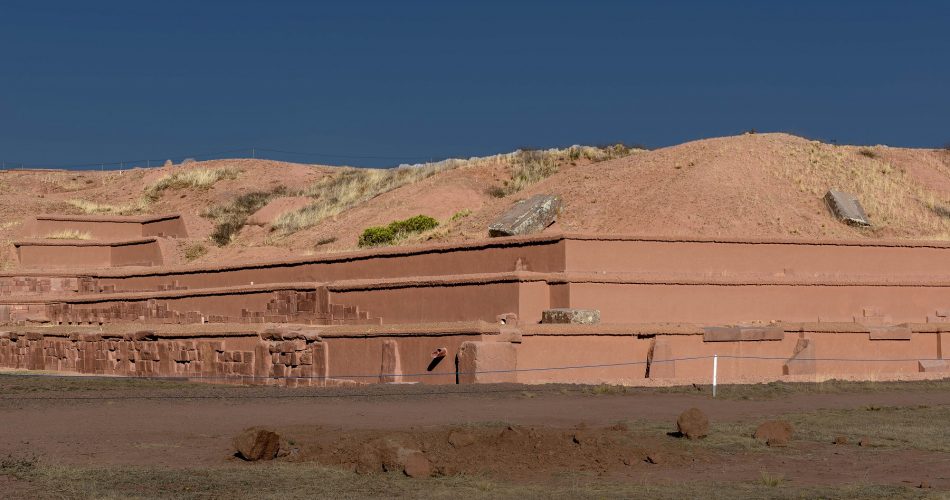- The Akapana Pyramid at Tiahuanaco is essentially a step pyramid whose core is made out of soil. It is faced with massive, megalithic stones.
- The largest stone used in the construction of the Akapana pyramid at Tiahuanaco weighs a stumping 65.7 tons.
- Tiahuanaco is home to some of the largest megalithic structures on Earth; the largest stone on the site—called Plataforma litica—is estimated to weigh 131 metric tons.
South and Central America are a treasure trove of pyramids. In Brazil, we have structures that have been identified by archaeologists as the oldest known pyramids on the surface of the planet, dating back up to 5,000 years. Not far to the north, in present-day Peru, we have an ancient city-state called Caral where archaeologists have found massive structures, evidence of an advanced civilization, and truly great pyramids.
Although dating the pyramids of Caral is difficult because we can’t radiocarbon date stone, experts believe that the monuments erected in present-day Peru are contemporaneous with the appearance of the first pyramids in Egypt. According to experts, the first Egyptian pyramid can be traced back to the Third Dynasty reign of King Djoser, when he directed his royal vizier and architect Imhotep to build a monument at the royal Necropolis of Saqqara.
Not far from Peru, the ancient city of Caral and the adobe pyramids of Peru are remnants of more pyramids. In present-day Bolivia, we find evidence that pyramids were far more widespread in South America than what we’ve believed until now.
Tiahuanaco—a wonder of ancient engineering
Tiahuanaco—also dubbed Tiwanaku—is a massive archaeological site in western Bolivia not far from Lake Titicaca. The site is one of the largest most impressive archeological complexes in South America. The surface remains uncovered to date spread across an area of approximately four square kilometers and includes monumental structures, megalithic blocks, and pyramids.
Believed to have been the center of a highly developed society, experts estimate that Tiahuanaco was home to more than 20,000 people, more than 1,200 years ago, although some argue that the city and its megalithic strictures go further back in history.
The megalithic structures of the site were first recorded in written history around 1550 when Pedro Cieza de Leon—a Spanish conquistador—was searching for the ancient Inca capital of Qullasuyu. But the history of the site prior to de Leon is shrouded in mystery.
That’s because its inhabitants, although extremely developed and capable, did not leaven behind written records that could help us understand the exact purpose, date, and meaning of the site. Nonetheless and despite written records of the city’s founders, experts estimate that Tiahuanaco’s modern name is related to the Aymara word taypiqala which is translated to “stones at the center.” However, like the names of many ancient cities in Mesoamerica—take Teotihuacan as an example—the founding name of Tiahuanaco remains shrouded in mystery.
Arthur Posnansky, a well respected avocational archaeologist, believed that Tiahuanaco was around 11,000–17,000 years old. His dating of the site was based on the geological eras as well as archaeoastronomy.
The site is covered in megalithic blocks of stone, some of which bear incredible precision, almost as if cut with lasers. These stones attest that the inhabitants of Tiahuanaco were skilled stonemasons and knew how to cut and shape some of the hardest stones on Earth without the use of modern technologies.
The Akapana Step Pyramid
Among the most important structures that have been excavated to date we have the Pumapunku stepped platforms, the Kalasasaya, the Kheri Kala, and the Akapana Step Pyramid.
The Akapana is perhaps the least known, yet most striking structure at Tiahuanaco because it proves that pyramid building techniques developed in Bolivia a long time ago. If Posnansky was right about his dates, it would mean that some of the earliest pyramids were developed in Bolivia, and not Brazil.
The Akapana is a morphed, cross-shaped pyramid measuring 257 meters wide, and is 197 meters broad at its maximum point. It was built to a height of nearly 17 meters. The pyramid features sunken fourth at its center. On the western side of the structure, we see a staircase decorated with sculptures.

The most interesting part of the pyramid is its interior or core. Unlike Egyptian pyramids which had a core made out of roughly cut stones, the Akapana is a man-made earthen mound, faced with a mixture of large and small stone blocks.
The soil that makes up the mound of the pyramid’s core is believed to have been dug up from the trench that not surrounds the site. However, and perhaps most surprisingly, some of the largest blocks of stone used in the construction of the outer faces of the pyramid are made of andesite. Archaeological surveys of the site have revealed that the largest blocks used in the construction of the pyramid weigh nearly 67 tons. It remains a profound mystery as to how the ancient inhabitants of Tiahuanaco managed to quarry the andesite and then transport it and place it into position, thousands of years ago.
The exact purpose of the pyramid remains debated, although, as revealed by S. T. Evans and J. Pillsbury, the structure may have served for the shaman-puma relationship of transformation through shape-shifting. Numerous puma and human heads were built on the upper terraces of the structure.
The same builders of the Akapana pyramid and the megalithic structures at Tiahuanaco are—very likely—responsible for even larger stones at the Puma Punku complex located next to the pyramid. The Puma Punku complex was constructed on an east-west axis just as the Akapana pyramid. It has a rectangular shape and is topped by megalithic blocks. The most prominent feature discovered to date at Puma Punku is the so-called “Plataforma Litica” which contains the largest stone block found at the site. According to the archeological surveys of the site, this massive stone has an estimated weight of 131 metric tons.
The second-largest stone at Puma Punku has an estimated weight of 85 metric tons.

